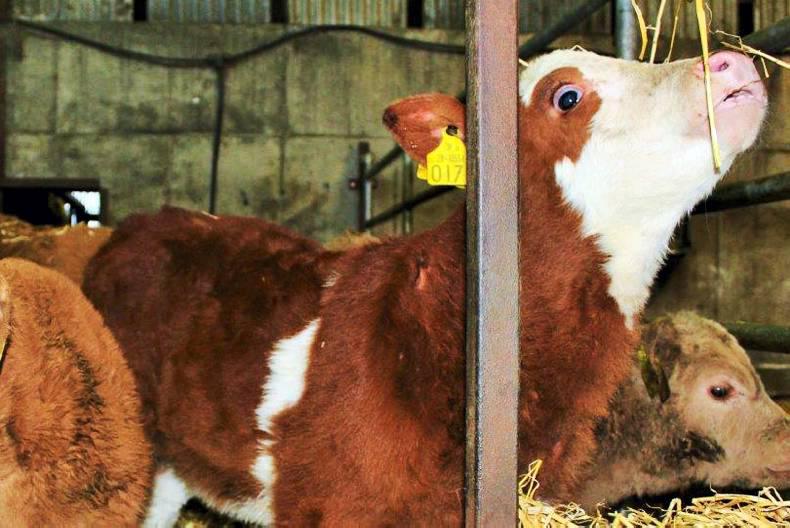Learning to play chess is not something I have ever done; but I know that chess is a game of strategy, and little is left to luck—anticipating the next move is key. Sales day in a livestock mart can be a lot like that. And I get a front row seat to all of those key moves every Thursday and Saturday at Kingscourt Mart, working as an auctioneer and mart manager.
But the sales yard is not the only thing keeping me busy: my week is split in two between farming and auctioneering. I won’t pretend the split is even, a neat one, nor—despite best efforts—is it always controlled. Like calving season, it gets messy.
Two rings running on a typical mart day
Located in southeast Cavan, close to the borders of Meath and Monaghan, Kingscourt Mart has been in business since the ‘50s. On a typical mart day, we have two rings running. In the top ring, bullocks are bought and sold, and in the bottom ring it is heifers and cows. I take the bottom ring while Nigel Gilmer, a quick-witted and driven auctioneer, takes the top ring. We’ve both been in the game a while, Nigel, about 25 years, and me nearly 20.
The bullock ring kicks off at 12 o’clock, and my ring at 1 o’clock. This time of the year the numbers of animals through the ring are, while not low, still gathering momentum before hitting their peaks in March and April and then in October and November. At peak times last year, we had weekly numbers in excess of 1,000 animals racing through the rings. Trade was good.
From my vantage point on the bench, sat four or five feet above the selling ring, I see a lot that most might not – victorious buyers, disgruntled bidders and all of the power plays
From my vantage point on the bench, sat four or five feet above the selling ring, I see a lot that most might not – victorious buyers, disgruntled bidders and all of the power plays. Plays worthy of Gary Kasparov. Rarely in the auction process does anything happen by chance.
Let’s say I’m a buyer, and on sales day I’ve spent all morning looking for a particular animal, a Limousin heifer. I know the weight, the build, the temperament I want, and I’ve spotted one, one that ticks all the boxes. I want it, I must have it. I stand well back from the ring, surveying all of the others leaning in, and milling about: the competition. The Limousin trots in, a prize animal in my eyes, and bidding is about to start and I’m focused; but then someone ambles over to me: ‘How’ya Lisa, how’s things? How’s your mother?’
I’m caught up chatting, and on the fall of the hammer, the Limousin goes to someone else. The conversation – was that by chance? Just a coincidence? Bad timing? Dramas like these play out every mart day, and coupled with the toing and froing of the auction battle itself, excitement is always high. I love it all, but returning to the farm can be a nice change.
Sleep deprivation
Like so many others, we are in the midst of calving season. Ours is relatively manageable with roughly 70 sucklers, 30 store cattle, and 10 autumn calving heifers. It keeps me and my mother busy, and a little sleep deprived.
Over the past few weeks, in reckless disregard to our sleeping habits, 15 cows opted to calve between midnight and 4am. Some come naturally, others need a hand, a few need an arm. And the calving jack comes into play too; I man the jack while my mother attends to the disinfecting, the bedding and the clean-up. I get the easy end of it.
Pay-per-view doesn’t get a look-in: ‘Cow TV’ we call it, and it’s invaluable
Monitoring calving this year and last has been made easier by technology. Cameras in the calving pens are connected to our home, located a couple of hundred metres away from the yard. Agitated cows on the verge of delivery are watched in glorious Technicolor on the television set, mobile phone, or tablet every day and night. Pay-per-view doesn’t get a look-in: ‘Cow TV’ we call it, and it’s invaluable.
Last year, while on holiday in Australia, I could warn my sister Áine, in Ireland, to switch on ‘Cow TV’ and get over to the yard because one was about to pop. She phoned my uncles to come up and deliver the calf—technology, and family, are worth their weight in gold at times like these.
Between farming and the mart, I keep busy. My whole family does. I have a brother recently back from the Gold Coast in Australia – a hopeless farmer, he’ll admit that himself – but he pitches in now too. And he’s seen (and smelled) some things he can’t believe: giving cattle a “haircut” before dosing, the proper operation of the calving jack and – one which really stuck – how to remove the “cleanings” from inside of a cow who hasn’t done it herself, naturally.
Seeing his reactions, retches, and responses are hilarious, but they are useful too. Seeing things through someone else’s eyes teaches you more, about yourself, about how you farm, and reminds you of the fun – and funniness – in all of it.






 This is a subscriber-only article
This is a subscriber-only article














SHARING OPTIONS: